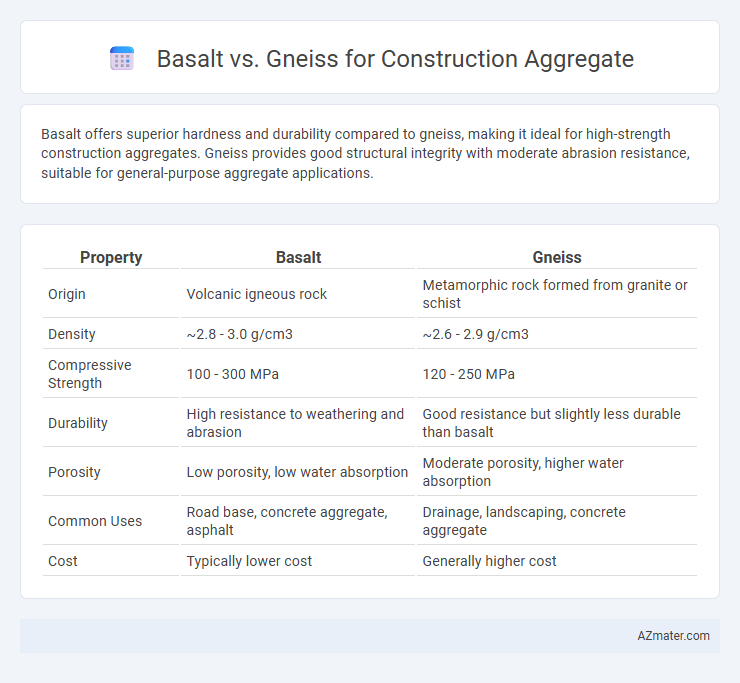Basalt offers superior hardness and durability compared to gneiss, making it ideal for high-strength construction aggregates. Gneiss provides good structural integrity with moderate abrasion resistance, suitable for general-purpose aggregate applications.
Table of Comparison
| Property | Basalt | Gneiss |
|---|---|---|
| Origin | Volcanic igneous rock | Metamorphic rock formed from granite or schist |
| Density | ~2.8 - 3.0 g/cm3 | ~2.6 - 2.9 g/cm3 |
| Compressive Strength | 100 - 300 MPa | 120 - 250 MPa |
| Durability | High resistance to weathering and abrasion | Good resistance but slightly less durable than basalt |
| Porosity | Low porosity, low water absorption | Moderate porosity, higher water absorption |
| Common Uses | Road base, concrete aggregate, asphalt | Drainage, landscaping, concrete aggregate |
| Cost | Typically lower cost | Generally higher cost |
Introduction to Basalt and Gneiss as Construction Aggregates
Basalt and gneiss are widely used construction aggregates due to their durability and strength. Basalt, a dense volcanic rock, offers excellent compressive strength and resistance to abrasion, making it ideal for heavy-duty construction projects like road bases and concrete production. Gneiss, a metamorphic rock characterized by its foliated texture, provides structural stability and resistance to weathering, suitable for decorative aggregates and structural fill applications.
Geological Formation and Mineral Composition
Basalt, a fine-grained igneous rock formed from rapid cooling of lava, primarily consists of plagioclase, pyroxene, and olivine minerals, offering high density and durability ideal for construction aggregate. In contrast, gneiss is a foliated metamorphic rock derived from granite or sedimentary rock, characterized by alternating bands of quartz, feldspar, and mica, which can affect its strength and fracture patterns in structural applications. Geological formation differences influence their mechanical properties, with basalt's volcanic origin yielding more uniformly hard particles, whereas gneiss's metamorphic layering can introduce planes of weakness.
Physical Properties: Strength and Durability
Basalt exhibits high compressive strength, typically ranging from 100 to 300 MPa, making it an ideal choice for heavy-duty construction aggregate applications. Gneiss also possesses considerable strength, usually between 80 and 250 MPa, but its foliated structure can lead to anisotropic durability under stress. Basalt's fine-grained, dense composition enhances its durability against weathering and abrasion, whereas gneiss, with its banded mineral layers, may show variable resistance depending on mineral alignment and foliation degree.
Engineering Performance and Load-Bearing Capacity
Basalt offers superior compressive strength and durability compared to gneiss, making it a preferred choice for high-load construction aggregate applications. Gneiss, while slightly less dense, provides excellent resistance to weathering and thermal expansion, contributing to long-term structural stability. Both materials demonstrate strong load-bearing capacities, but basalt's uniform granular structure typically results in enhanced engineering performance for heavy-duty infrastructure projects.
Weathering Resistance and Longevity
Basalt exhibits superior weathering resistance compared to gneiss due to its dense, fine-grained structure and high compressive strength, making it highly durable as construction aggregate. Gneiss, characterized by its foliated texture and mineral banding, can be more susceptible to physical and chemical weathering, potentially reducing its longevity in exposed applications. Long-term performance of basalt aggregates in infrastructure projects often surpasses that of gneiss, contributing to extended service life and reduced maintenance costs.
Absorption, Porosity, and Freeze-Thaw Behavior
Basalt demonstrates lower absorption rates and porosity compared to gneiss, making it more resistant to water infiltration and reducing the risk of structural weakening. Its dense, fine-grained texture contributes to superior freeze-thaw durability, minimizing the likelihood of cracking and spalling in cold climates. Gneiss, with higher porosity and absorption, is more vulnerable to freeze-thaw cycles, which can lead to aggregate degradation and compromised construction longevity.
Workability and Processing Costs
Basalt is preferred for construction aggregate due to its high durability and workability, offering easier crushing and shaping compared to gneiss. Gneiss, with its foliated structure, tends to require more complex processing and higher costs to achieve similar aggregate quality. The lower processing costs of basalt combined with consistent physical properties make it more economical and efficient for large-scale construction projects.
Environmental Impact and Sustainability
Basalt exhibits a lower environmental impact compared to gneiss due to its higher durability and reduced need for frequent replacement in construction aggregates, leading to less mining and energy consumption over time. Gneiss, while strong, often requires more processing and results in higher carbon emissions during extraction and transportation. The sustainability of basalt as an aggregate is enhanced by its abundant availability and minimal environmental degradation during quarrying, making it a preferred choice for eco-friendly construction projects.
Common Applications in Construction Projects
Basalt is widely used as construction aggregate due to its high compressive strength, durability, and resistance to abrasion, making it ideal for road base, concrete aggregate, and railway ballast. Gneiss, characterized by its foliated texture and strong mineral composition, is commonly utilized in decorative stone applications, aggregate for concrete, and landscaping projects where aesthetic appeal is important. Both rocks provide structural integrity, but basalt's dense and uniform composition often leads to superior performance in heavy load-bearing construction environments.
Comparative Analysis: Which is Better for Aggregate Use?
Basalt and gneiss are both popular choices for construction aggregate due to their durability and strength. Basalt, an igneous rock, typically offers higher compressive strength and better resistance to weathering compared to gneiss, a metamorphic rock known for its layered structure and variable hardness. For heavy-duty applications like road base, concrete aggregate, and railroad ballast, basalt is often preferred, while gneiss may be suitable for decorative or less intensive uses due to its aesthetic appeal and moderate physical properties.

Infographic: Basalt vs Gneiss for Construction Aggregate
 azmater.com
azmater.com